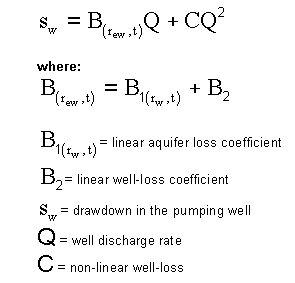Predicting Well Drawdown at Different Pumping Rates
Predicting Drawdown at Different Pumping Rates
See Also:
A primary reason for performing step drawdown test is to predict the performance of a well at different pumping rates.
Hantush-Bierschenk Analysis
To determine drawdown in a well at time t using the Hantush-Bierschenk method, the entire procedure must be performed. The resulting well loss coefficients B and C will be valid only for the time t selected for the test. This time is entered from Edit | Aquifer Parameters and is referred to delta T in the StepMaster program and documentation. Delta T is the time from the beginning of a step to the time at which Sw is determined for that step.
After the desired time is entered and the analysis completed, well loss coefficients B and C will be obtained. Drawdown in the well at time t can then be determined for any pumping rate using the equation:

and consistent units are maintained (Kruseman and de Ridder).
It is important to realize that B and C are dependent on t for the Hantush-Bierschenk method.
Eden-Hazel Method
Following analysis by the Eden-Hazel method, drawdown in a well at time t, and pumped at a constant rate Q can be estimated from the equation:
![]()
where:
a = the y-intercept of the graph obtained in Part 2 of the Eden-Hazel analysis in units of time/length2
b = the slope of the parallel lines graphed in Part 1 of the Eden-Hazel analysis in time/length2
c = the slope of the graph obtained in Part 2 of the Eden-Hazel analysis in units of time2/length5
sw is the drawdown in the well at time t
t = the time at which drawdown is determined
Q = the constant well discharge rate